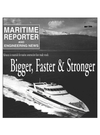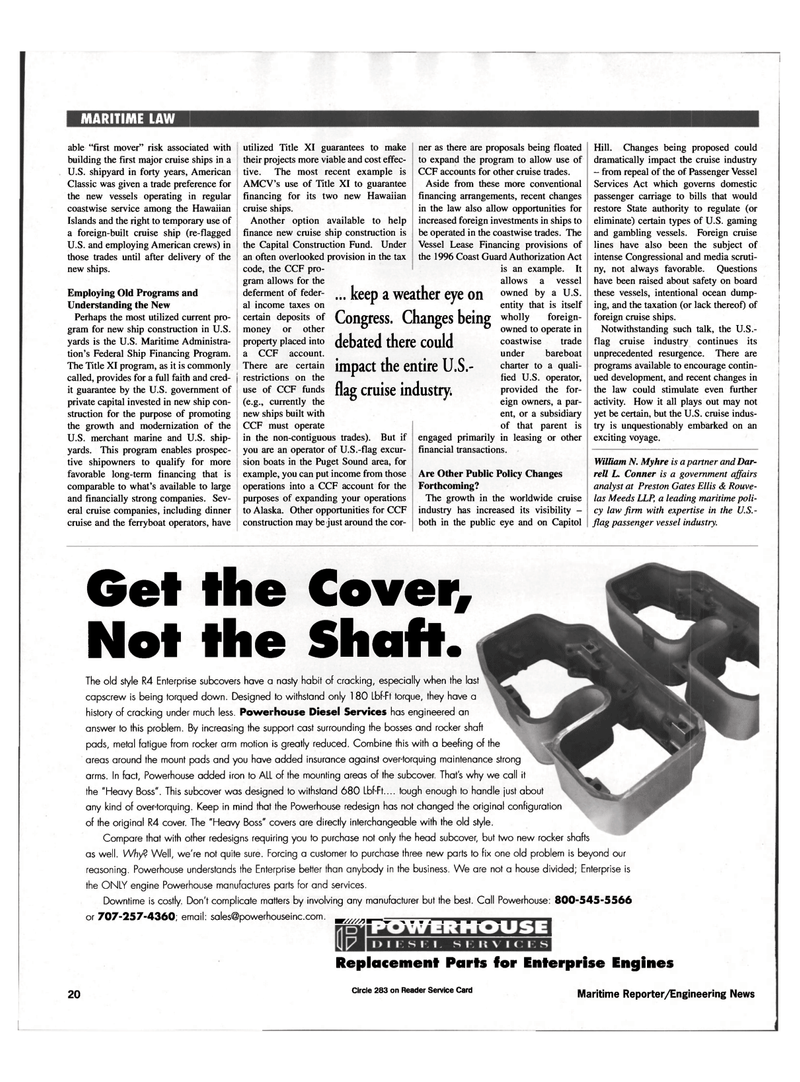
Page 20: of Maritime Reporter Magazine (May 1999)
Read this page in Pdf, Flash or Html5 edition of May 1999 Maritime Reporter Magazine
MARITIME LAW able "first mover" risk associated with building the first major cruise ships in a
U.S. shipyard in forty years, American
Classic was given a trade preference for the new vessels operating in regular coastwise service among the Hawaiian
Islands and the right to temporary use of a foreign-built cruise ship (re-flagged
U.S. and employing American crews) in those trades until after delivery of the new ships.
Employing Old Programs and
Understanding the New
Perhaps the most utilized current pro- gram for new ship construction in U.S. yards is the U.S. Maritime Administra- tion's Federal Ship Financing Program.
The Title XI program, as it is commonly called, provides for a full faith and cred- j it guarantee by the U.S. government of private capital invested in new ship con- struction for the purpose of promoting the growth and modernization of the
U.S. merchant marine and U.S. ship- yards. This program enables prospec- tive shipowners to qualify for more favorable long-term financing that is comparable to what's available to large and financially strong companies. Sev- eral cruise companies, including dinner cruise and the ferryboat operators, have utilized Title XI guarantees to make their projects more viable and cost effec- tive. The most recent example is
AMCV's use of Title XI to guarantee financing for its two new Hawaiian cruise ships.
Another option available to help finance new cruise ship construction is the Capital Construction Fund. Under an often overlooked provision in the tax code, the CCF pro- gram allows for the deferment of feder- al income taxes on certain deposits of money or other property placed into a CCF account.
There are certain restrictions on the use of CCF funds (e.g., currently the new ships built with
CCF must operate in the non-contiguous trades). But if you are an operator of U.S.-flag excur- sion boats in the Puget Sound area, for example, you can put income from those operations into a CCF account for the purposes of expanding your operations to Alaska. Other opportunities for CCF construction may be just around the cor- ner as there are proposals being floated to expand the program to allow use of
CCF accounts for other cruise trades.
Aside from these more conventional financing arrangements, recent changes in the law also allow opportunities for increased foreign investments in ships to be operated in the coastwise trades. The
Vessel Lease Financing provisions of the 1996 Coast Guard Authorization Act is an example. It allows a vessel owned by a U.S. entity that is itself wholly foreign- owned to operate in coastwise trade under bareboat charter to a quali- fied U.S. operator, provided the for- eign owners, a par- ent, or a subsidiary of that parent is engaged primarily in leasing or other financial transactions.
Are Other Public Policy Changes
Forthcoming?
The growth in the worldwide cruise industry has increased its visibility - both in the public eye and on Capitol
Hill. Changes being proposed could dramatically impact the cruise industry - from repeal of the of Passenger Vessel
Services Act which governs domestic passenger carriage to bills that would restore State authority to regulate (or eliminate) certain types of U.S. gaming and gambling vessels. Foreign cruise lines have also been the subject of intense Congressional and media scruti- ny, not always favorable. Questions have been raised about safety on board these vessels, intentional ocean dump- ing, and the taxation (or lack thereof) of foreign cruise ships.
Notwithstanding such talk, the U.S.- flag cruise industry continues its unprecedented resurgence. There are programs available to encourage contin- ued development, and recent changes in the law could stimulate even further activity. How it all plays out may not yet be certain, but the U.S. cruise indus- try is unquestionably embarked on an exciting voyage.
William N. Myhre is a partner andDar- rell L. Conner is a government affairs analyst at Preston Gates Ellis & Rouve- las Meeds LLP, a leading maritime poli- cy law firm with expertise in the U.S.- flag passenger vessel industry. ... keep a weather eye on
Congress. Changes being debated there could impact the entire U.S.- flag cruise industry.
Replacement Parts for Enterprise Engines 20 Circle 283 on Reader Service Card Maritime Reporter/Engineering News
Get the Cover,
Not the Shaft.
The old style R4 Enterprise subcovers have a nasty habit of cracking, especially when the last capscrew is being torqued down. Designed to withstand only 1 80 Lbf-Ft torque, they have a history of cracking under much less. Powerhouse Diesel Services has engineered an answer to this problem. By increasing the support cast surrounding the bosses and rocker shaft pads, metal fatigue from rocker arm motion is greatly reduced. Combine this with a beefing of the areas around the mount pads and you have added insurance against over-torquing maintenance strong arms. In fact, Powerhouse added iron to ALL of the mounting areas of the subcover. That's why we call it the "Heavy Boss". This subcover was designed to withstand 680 Lbf-Ft.... tough enough to handle just about any kind of over-torquing. Keep in mind that the Powerhouse redesign has not changed the original configuration of the original R4 cover. The "Heavy Boss" covers are directly interchangeable with the old style.
Compare that with other redesigns requiring you to purchase not only the head subcover, but two new rocker shafts as well. Why? Well, we're not quite sure. Forcing a customer to purchase three new parts to fix one old problem is beyond our reasoning. Powerhouse understands the Enterprise better than anybody in the business. We are not a house divided; Enterprise is the ONLY engine Powerhouse manufactures parts for and services.
Downtime is costly. Don't complicate matters by involving any manufacturer but the best. Call Powerhouse: 800-545-5566 or 707-257-4360; email: [email protected]. ^ , .. . .. ^

 19
19

 21
21
